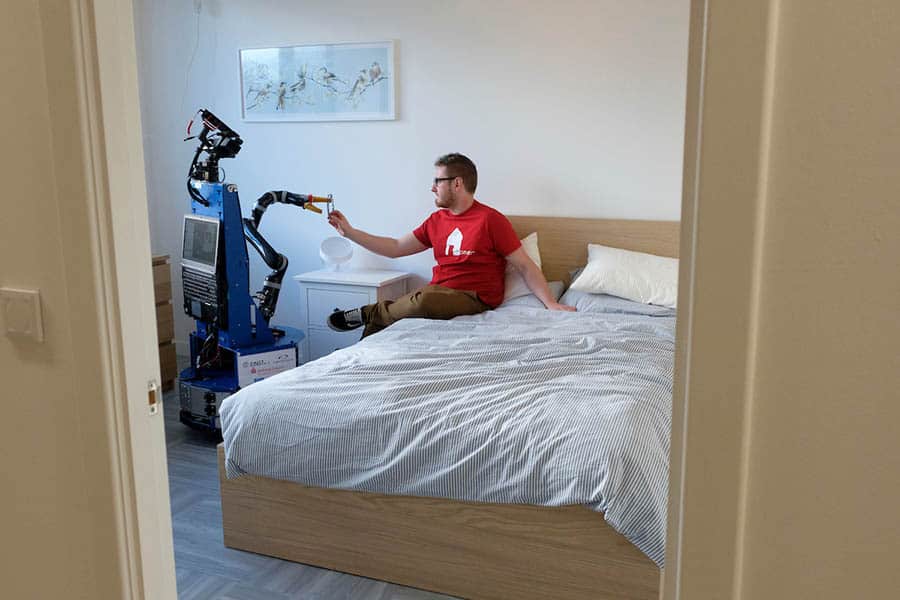Guest article: How robotics can help slow cognitive decline and support independent living for longer

In this guest article, Professor Lynne Baillie, who specialises in Human-Robot Interaction and social care at The National Robotarium at Heriot-Watt University, explores how robotics can support independent living and result in significant financial savings for local authorities.
Currently, our homes are not sufficiently equipped to support people experiencing cognitive decline. However, there exists huge potential for robots, sensors and IoT (Internet of Things) devices to complement existing social care services, helping individuals with a range of assisted living needs to live independently in their own homes for longer. Research in this area is gathering pace, exploring what the needs are, which robots can best meet these requirements, and what additional challenges the deployment of robots in domestic settings may bring.
MiRo and Pepper
Though the use of robotics in a social care setting is still at an early stage of development, some positive early results have been achieved in this field. For example, MiRo robots have been used to recognise and assess falls. False alarms and emergency call outs for falls from which a person is able to get up without assistance puts additional pressure on the resources of councils and housing associations annually. The MiRo, an autonomous robot which is designed to resemble a pet, asks questions and uses touch sensors and computer vision to establish whether a fall victim is conscious and capable of getting up without assistance. If it receives no response, the MiRo is able to alert an emergency contact.
In another collaborative research project between the National Robotarium and Chest, Heart, Stroke Scotland, we explored with stroke survivors how different robots could assist them in their daily lives. One outcome was that stroke survivors wished to have augmented physical therapy. As a result of this insight, we started working with physiotherapists at the Astley Ainslie Hospital in Edinburgh to investigate what would be needed to deliver such therapy via a Pepper humanoid robot. The aim is that the Pepper robot will provide additional therapy in between formal sessions with a physiotherapist in order to continue their exercises and track their progress.
Early intervention in cognitive decline
In terms of cognitive decline, robots can provide valuable support through early intervention – replicating the interactions and therapies that a patient may receive during the later stages of diagnosis. It can encourage early participation in therapies and attempt to stem the decline by way of robotic coaching as well as through various interactive activities. The emphasis is on early intervention to improve the overall trajectory for the patient and to ensure best use of available resources further down the care pathway.
Additionally, robots and sensors can capture data over longer periods of time than humans and can continuously monitor the deterioration of some conditions such as dementia, highlighting to human carers when a review of a care package may be required.
Robotics research supporting independent living
The National Robotarium, based at Heriot-Watt University, is a world-leading centre for robotics and artificial intelligence research. A state-of-the-art facility is under construction on the Edinburgh campus which will be equipped with an Assisted Living Lab designed to trial technology in a realistic social care setting.
This will consist of a self-contained apartment with its own garden, disabled access, two bedrooms, a living room, bathroom and a fully equipped kitchen. Embedded throughout with a range of sensor technologies, it will allow researchers, collaborating with care providers and end users, to assess to what extent home environments need to be monitored in order to provide assisted living support. In this way, research can be carried out in a controlled environment, eliminating the need to intrude in people’s homes. The National Robotarium’s policy is one of privacy by design. Rather than collecting data that is extraneous or unnecessary, researchers carefully establish the data requirements and limit data collection to only what is essential. It is difficult to retrofit privacy into design, and far better practice to embed it from the start.
Challenges posed by robots
There are, of course, practical, operational limitations with robots to consider. For example, many robots can’t climb stairs well. While competent at simple tasks, most robots are challenged by the unexpected. Trust and ethics are potentially limiting factors, and these are being studied in depth by roboticists to develop an understanding of the limitations of current human-robot interaction.
However, key challenges remain around the use of robots in social care and their acceptability in people’s homes. Robots are early in their evolution, without responsibility and can behave in unexpected ways. In a recent study focusing on robots and social distancing, participants eventually became frustrated with the robots. Tolerance for robots is an area that needs further exploration – how willing are people to ensure robots are always charged, how competent are people to undertake the set up of a robot, what level of interaction with robots are most people comfortable with? It is this sort of information that needs to be understood to assess which robot technologies will ultimately be most suitable to deploy in the home environment.
The Covid pandemic has proved to be a major block to research into robotics and independent living in the last year, prohibiting any in-person studies. Without access to patients, the role of health care professionals in our research has become all the more valuable: collaboration is vital in accelerating the adoption of robotics to support existing care packages.
Budgetary considerations pose a further challenge to the use of robots in supporting independent living. While their adoption will not necessarily save the NHS money at the outset, robots can lead to better economic outcomes at different points in the care pathway. For example, delaying the admission of someone into a care home is often the preferred course of action for an individual and their family which can also result in significant financial savings for a council. The long-term strategic aim of our research is to give people the opportunity to enjoy their own home for as long as possible.
Collaboration and diversity are key
To be effectively embedded in society, robotics needs greater diversity in terms of research, technology creation and policy. Heriot-Watt University has established a number of two-year MSc bridging courses – in human-robot interaction, artificial intelligence and data science – to enable people from non-technical areas to obtain a computing qualification and enter the field of robotics.

It is important to have more diversity in research into computer science and robotics in order to avoid the unintended consequences of a male-dominated industry. For example, speech recognition systems have previously been designed and built by young male computer scientists and, as a result, speech recognition systems work optimally for this user group and not as well for others such as older female adults. It is essential that robots are created to work for a broader section of the population and vital that unintentional discrimination in the design and build of technology is avoided.
The National Robotarium is also a collaborative environment and through research partnerships we look to demystify robotics. We will only develop useful and applicable solutions if our work is underpinned by successful collaboration.
We aim to bring together the many disparate organisations involved in health care and assistive living, from the NHS and health care professionals, rehabilitation experts such as physiotherapists and occupational therapists, to housing associations, charities, industry and, perhaps most important of all, the end users. We will not get to the point of developing appropriate robotic solutions for the social care setting without this wide collaboration. As a result, the National Robotarium welcomes new partnerships and approaches from interested organisations.
By combining robotics research with expertise from the care sector, we can tackle current challenges head-on while also establishing long-term, cost-effective solutions to the wider issues faced by individuals with cognitive decline and assisted living needs in the home.
About Professor Lynne Baillie
Professor Baillie’s research focuses on the interaction between humans and technology, and the development and evaluation of novel interactive technologies. Working alongside Chest Heart & Stroke Scotland and housing associations, Lynne’s interests include health and rehabilitation technologies. She heads up the Assisted Living Lab and the Interactive and Trustworthy Technologies Research Group, exploring technologies to help individuals live independently for longer, with research ranging from robotics and conversational assistants to IoT devices and wireless monitoring techniques.


